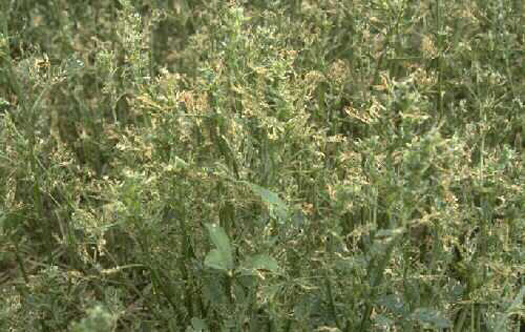 | |
| https://entomology.k-state.edu/extension/insect-information/crop-pests/alfalfa/ | alfalfa-weevil.html |
Light brown with a dark stripe down their back, measuring
approximately ¼ of an inch in length with a pronounced snout these small
beetles are rather drab and unassuming. What they lack in the looks and size
department, they more than make up for in the appetite department. Adults spend
the winter months hidden within the stems of the alfalfa plant, or among leaf
litter and other debris. In early spring they become active and egg laying
begins. Eggs are laid within the stems of newly developing plants. The larva
will make their way to the leaves where they will begin feeding. Newly hatched
larvae leave behind tiny pin-hole size feeding evidence that is noticed as the
leaves begin to unfurl. As the larva grow, so too does the size of the feeding
holes. If the population of larvae is too excessive the leaves will take on a
skeletonized appearance and excessively infested fields may look gray or
whiteish from a distance.
Another hay crop pest called the Clover Leaf Weevil is
very similar in appearance and often shares the same fields with the Alfalfa
weevil. To determine which weevil is feeding on your crop, pay close attention
to the larvae. The CLW will have a brown head, whereas the AW has a black head.
Nearly all the damage done to the annual alfalfa crop is done by the larvae.
Adults are not known to cause any significant damage as they typically feed on
the edges of the leaves near the bottom of the plants. Although exceptions
exist. If the adults begin feeding on the newly developing plant stems after
the first cutting, this may cause something known as Bark Feeding and cause
damage to newly developing stems. 
https://agcrops.osu.edu/newsletter/corn-newsletter/2018-09/when-begin-alfalfa-weevil-scouting
 |
| https://ohioline.osu.edu/factsheet/ENT-32 |
We should always be mindful when making the decision to utilize chemical control of pests. Over usage of chemicals can and will create super pests. The premise is that approximately 5% of pests will survive the chemical onslaught, these nearly 5% will carry a certain amount of resistance into the next generation. Within a few generations most of the pests you are targeting will have some if not complete resistance to the chemicals you are using. Chemicals are not species specific in their target. Meaning, when you spray chemicals you aren’t just killing your desired target, but also beneficial insects, such as lady beetles, lacewings, damsel bugs and other predators of the pest you are trying to eliminate. You are also putting at risk other beneficial insects such as pollinators.
Numerous predatory wasps have been introduced throughout the United States from Asia and other countries where the Alfalfa weevil originated. These predators evolved with the weevil and provide excellent population control in their native home. Several of these predatory wasps are now well established in the United States and may control as much as 35% of weevil populations in each location. If you have several wasp species within the same field all the better for control. Lady Beetles, Lacewings, and Damsel Bugs are all predatory at some stage in their lives and do an excellent job of controlling pest insects. As too does birds, bats and small mammals.
 |
| https://commons.wikimedia.org/wiki/File:Hypera_postica_P1650452a.jpg |
During springs when the weather is wet and warm a naturally occurring fungus consumes the weevils, killing as much as 90% of their population. Slow moving weevils that range in color from pale yellow to black are a strong indication this fungus is at play. Within a few days infected weevils will perish.
Being vigilant and keeping a close watch on your fields in early spring will go a long way in making the appropriate decision about control measures of this invasive, and well-established hay pest. Further questions or concerns should always be discussed with your local extension office. They are equipped to offer the best advice for your situation.

No comments:
Post a Comment